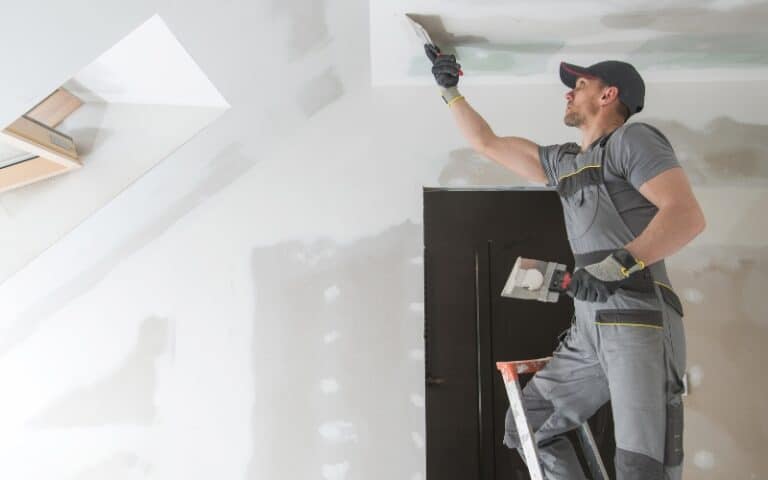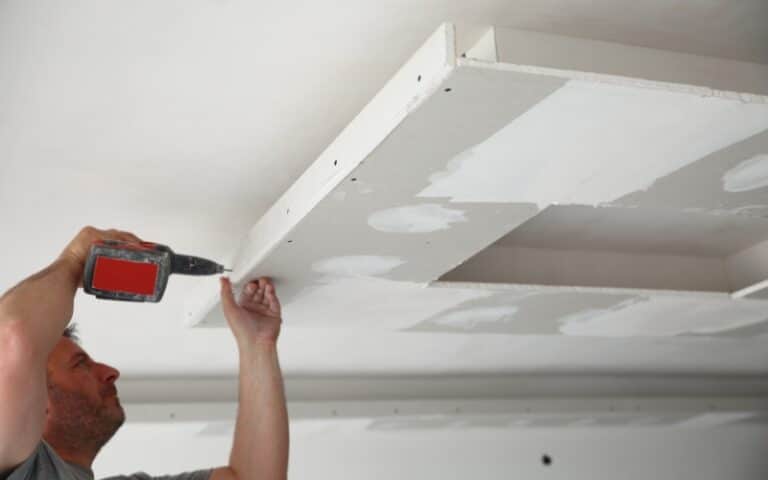Priming is an integral part of your project when using drywalls. Before adding paint or wallpaper, preparing the wall surface for the finishing layer is necessary.
Primer comes in different forms and types. A popular type is the oil-based primer. This type of primer has a wide range of use.
However, if you are heading to the store for a primer, you will likely wonder which type is best for your drywall. Should you go for the versatile oil-based primer?
Oil-based is not the best for drywall projects. There are other better options. However, some situations require using oil-based primer on drywall. Although oil-based drywall does not give you a smooth finish, you can sand the wall as desired. You can use other types of primer for your drywall to do your project.
In this article, I will explain the effect of oil-based primers on drywall. I will also explain the situations that require an oil-based primer on drywall and other alternatives.
At the end of the article, you will know all you need to decide for your next priming project.
Ready for a Drywall Quiz?
Can I Use an Oil-Based Primer on Drywall?

Depending on the situation or project, you can use oil-based primer on drywall. Ideally, there are better options for your drywall.
Due to the composition and grains on drywall, the oil-based primer does not give you an excellent finish.
However, there are instances where you should apply oil-based primer on drywall. These include:
#1. Putting up Wallpaper
When putting up a thick wallpaper, you need a primer that allows for the best adhesive contact. Oil-based primer is the best option for this project.
While oil-based primer is not the best for drywalls, it is suitable for wallpaper projects.
#2. Covering Hard Stains
It is better to opt for an oil-based primer when covering stains. Oil-based primer does an excellent job of sealing or covering stains, leaving you with a clean wall ready for new paint.
Note that other types of primer will also cover the stains. However, with oil-based primer, you only need one priming coat to clean the stain.
With other primers, you might need multiple layers depending on the stain. Oil-based primer saves time and prevents waste.
What Kind of Primer is Best to Use on Drywall?
Water-based primer or Latex primer is your best option for drywalls. One primary reason is the smooth finish water-based primer gives you after priming.
Your drywall is almost ready for painting after water-based priming. Water-based primer does not affect the surface; it only makes it better suited to painting.
When you use water-based primer, the structure of the drywall remains the same. It is the best option for your drywall project.
When you use oil-based primer on drywall with painting in view, you add extra work to your project. This type of primer affects the grain of the drywall.
It raises, and that leaves you with a rough finish. When you use an oil-based primer, you must sand the primed wall before painting.
That requires extra work and is also not advisable for health reasons. Water-based primer gives you a smooth finish and allows you to continue your work with the flow.
When Should You Use an Oil-Based Primer?
An oil-based primer works well on different types of surfaces. The components of the primer allow it to act as a stable base for your paint.
The primer is also efficient in covering cracks and rough patches. If you have an oil-based primer, consider using it on one of these occasions.
#1. Priming Fresh Wood
An oil-based primer is more effective in priming fresh wood. Fresh wood new to priming or painting has more moisture than old dry wood.
After installation, the water content in the wood continues to evaporate. When you use a water-based primer on such wood, evaporation affects the content of the primer.
It loses its adhesiveness to the wall. An oil-based primer is not affected by evaporation. It sticks to fresh wood and provides an adhesive surface for paints.
Unlike water-based primers, an oil-based primer does not flake off or peel due to evaporation. What about the smell of the stain?
A stain is not entirely gone if the smell still lingers on. Oil-based primer is the most effective option when covering smells.
If you are priming a wall stained with a smoke smell or a burning smell in the kitchen, then an oil-based primer is the best.
#2. Before Using Oil-Based Paint
If you plan on using oil-based paints on a wall, the best option is to use an oil-based primer before painting. This primer provides the best surfaces due to similarities in composition.
Note that you can use oil-based primer for water-based paints. However, it would help if you did not use water-based primers for oil-based paints.
It is better to use the same type of primer and paint for the same surface to get the best results.
#3. Exterior Surfaces
When priming exterior surfaces, it is best to use oil-based primers. Exterior surfaces usually suffer from weather fluctuations.
These walls are open to various conditions, including sunny mornings, cold evenings, rain, heat, and storms.
All these conditions affect the type of primer you use and determine if the paint will stick or not. Oil-based primer remains the same through these various conditions.
It helps to keep the paint on for much longer.
#4. Old Painted Wood
Oil-based primer is also the best option for old-painted woods. During the renovation, it is best to use a primer that helps to cover the roughness associated with use.
Painted woods usually have chalking-off areas and chipped parts, leaving uneven surfaces around the wall. The best option for this job is to use oil-based primers.
Note that it is necessary to scrape off the old paint as much as possible. It makes the priming work easier.
What Are the Upsides and Downsides of an Oil-Based Primer?
Oil-based primer is your best choice for numerous projects and repairs. However, there are upsides and downsides to using this primer.
Consider both sides carefully and decide which is best for your project. Here are the upsides to using this primer:
#1. Versatile Use
One significant upside of using an oil-based primer is its versatile use. The numerous uses of the oil-based primer mean you will need it at one point during your project.
It is also better to have a uniform primer for different walls. Hence, oil-based primer is the best option for old or new walls.
#2. Resistance to Mold Growth
You don’t have to worry about mold or mildew growth using oil-based primer for exterior surfaces.
Besides the primer ability to keep the wall fresh through different weather, it also shuts out any growth in the woods. Hence it is a stable source of protection for your exteriors.
#3. Resistant to Stains
Oil-based primer is excellent for removing or sealing stains and smells. It makes your old walls look new and smell nice. However, that is not the only upside of using oil-based primer.
This primer is also the best at resisting stains. Your walls remain clean and neat with simple and easy maintenance.
If you are painting areas highly exposed to touch and stain, oil-based is the best. This resistance to stain is another reason why it is popular.
Here are the downsides of oil-based primers:
#4. Hard to Apply
When applying primer for walls before painting, uniformity is critical. You want to apply it evenly throughout the surface to get a flat surface for your paint.
However, it isn’t easy to apply oil-based paint evenly. If you plan on having a DIY project, it is vital to be careful when applying oil-based primer.
If you are unskilled, it is best to call an expert to help with the application.
#5. Toxic in Large Quantity
Oil-based primers release volatile organic compounds during application. In small quantities, this compound is not toxic to the environment.
However, in large quantities, they pose health risks. Understandably, working in a well-ventilated area is the only way to keep the quantity down.
Ideally, oil-based primer is not good indoors without protective gear for your nose and mouth. Note that VOCs can adversely affect your health if inhaled continuously over time.
#6. Not Easy to Clean
Oil-based primers are indeed stain resistant. However, when they are stains, they become resistant to cleaning.
This property is another reason why oil-based primer application requires skills.
Also, cleaning the primer from the tools is extra tricky. It requires the use of paint thinners and other primer removal agents.
#7. Costly
The versatility of oil-based primer reflects in its extra average cost compared to other types of primer.
There are many types of oil-based primers, and they have varying prices based on use and brand. However, they cost more than latex primer. You should note that when budgeting.
Here is a table summarizing the upside and downsides of oil-based paints:
| Upside of Oil-Based Primer | Downside of Oil-Based Primer |
|---|---|
| Versatile | Hard or Tricky to Apply |
| Resistance to Stains | Toxic in Large Quantity |
| Resistance to Mold or Mildew | Not easy to clean or remove |
| Expensive |
What Kind of Primer Do You Use on Painted Walls?
Water-based primer is the best option when repainting painted walls. It is smooth and leaves with a surface easily adhesive for paints.
Water-based primers are also less likely to lead to bubbles or peels. However, note that oil-based primer is the best for exteriors that suffer from weather changes.
For interior paints, water-based primer is your go-to option. Here are instances where priming painted walls is necessary:
#1. Priming Over Peeling Old Paint
It is necessary to decide if you need priming on a painted wall. If the wall is smooth without cracks or peels, you might repaint without priming.
However, if you find rough patches or chunks of paint falling over, you must prime the wall.
#2. When Changing Colors
If you are changing the wall to a new paint that is different in shade from the old paint, then priming is necessary.
Painting lighter colors over old dark-colored paint leaves with mixed patches. You will need to paint several layers to have the new color.
However, with priming, you can easily cover the old paint and apply the new one.
#3. Oil-Based Painted Walls
When dealing with old walls with oil paint, then priming is essential. If you plan to change the wall to latex paint, use a water-based primer.
If the plan is to add oil paint on oil-based primer, you can proceed without priming if the wall is still in excellent condition.






